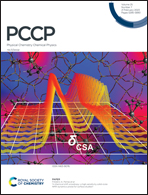First-principles screening of transition metal doped anatase TiO2(101) surfaces for the electrocatalytic nitrogen reduction†
Abstract
The electrocatalytic nitrogen reduction reaction (eNRR) has been attracting intensive scientific attention as a potential alternative to the industrial Haber–Bosch process for ammonia production. Although many materials have been investigated, optimal catalysts for the reaction remain to be found. In this work, we performed the theoretical screening of 3d–5d transition metal doped anatase TiO2 for the eNRR. The most favorable doping site of each transition metal on the (101) surface was located. We found that the doping of transition metals promotes the formation of oxygen vacancies which are beneficial for the reaction. The scaling relations between the energies of the key intermediates were investigated. Using a machine learning algorithm (SVM), we identified two adsorption modes for the end-on adsorbed *HNN, which exhibited different scaling relations with *NH2. From a two-step process, we screened out several candidates, among which Au and Ta were proposed to be the most efficient dopants. Electronic structure analysis reveals that they can efficiently lower the energy of the intermediates. These results should be helpful for the design of more efficient TiO2-based catalysts for the eNRR.



 Please wait while we load your content...
Please wait while we load your content...